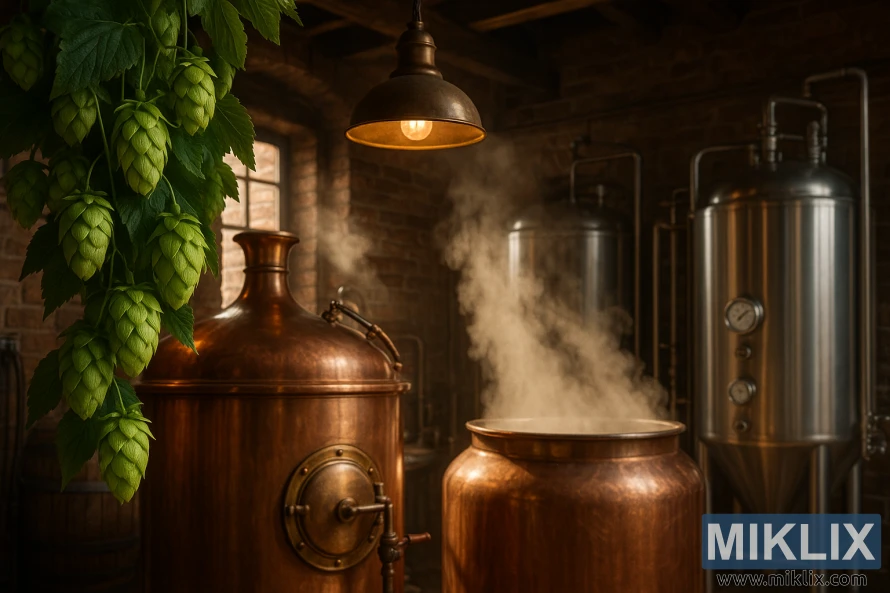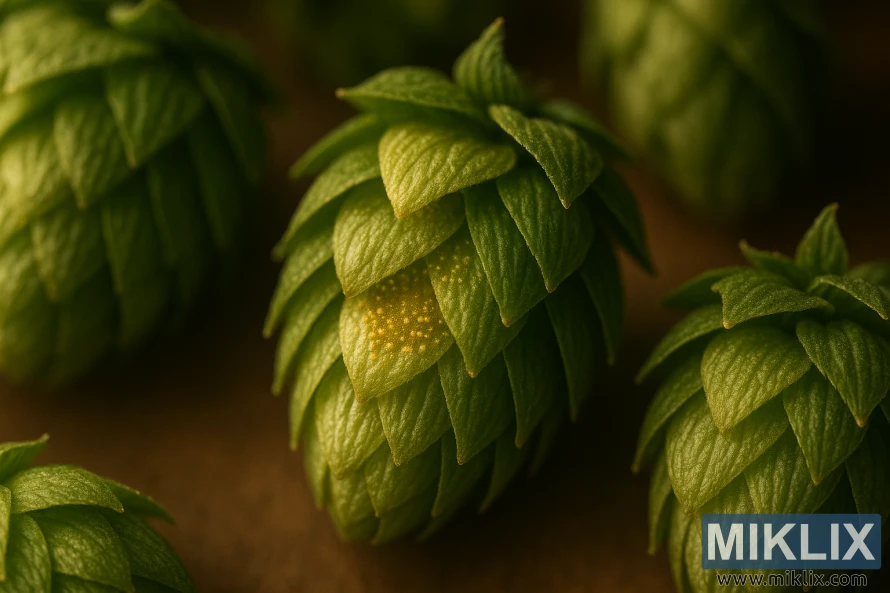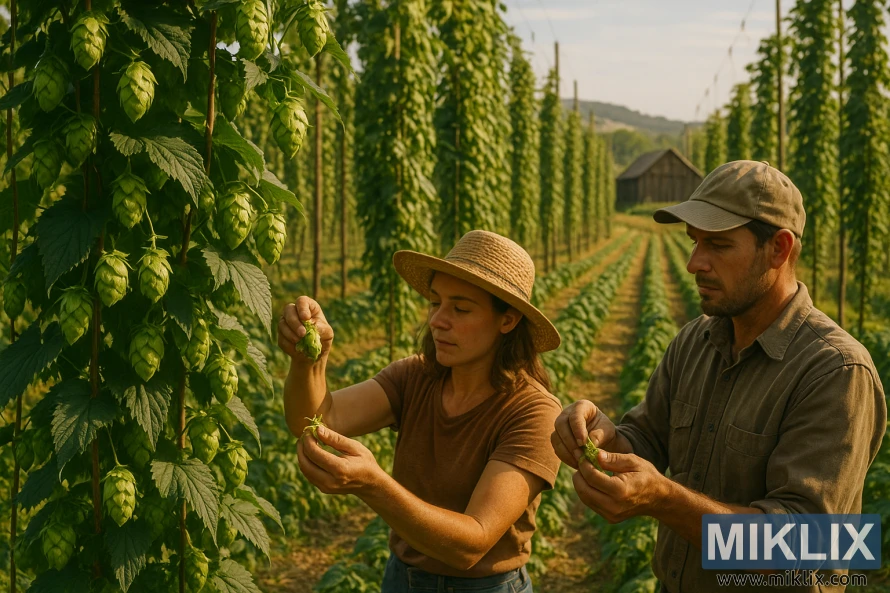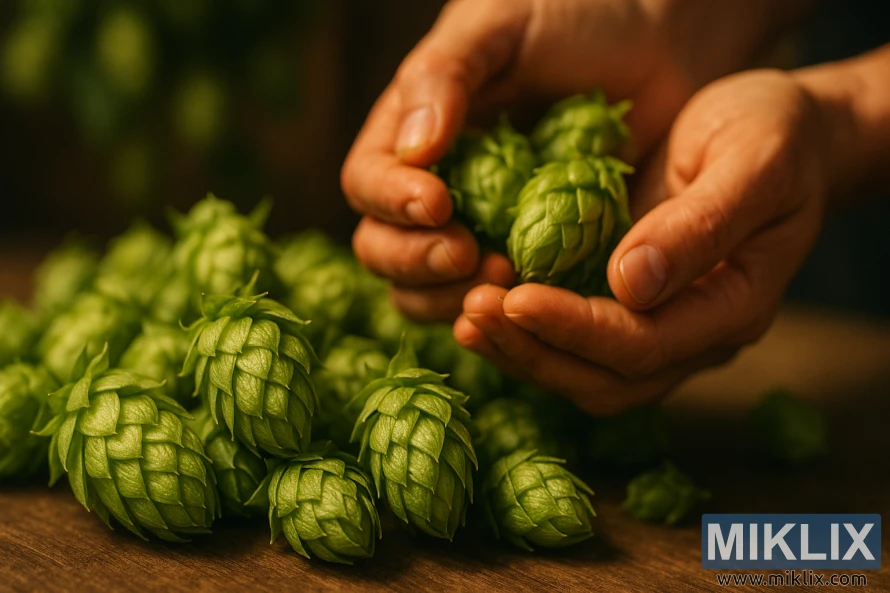Hops in Beer Brewing: Chinook
Published: July 31, 2025 at 8:27:58 AM UTC
Chinook hops have become a cornerstone in American craft brewing. They are celebrated for their unique aroma and their ability to add bitterness. This makes them a favorite among brewers, who appreciate their distinct flavor. It enhances a variety of beer styles, adding depth and complexity. For both homebrewers and commercial brewers, mastering the use of Chinook hops is key. This guide will dive into their characteristics, the best growing conditions, and their applications in brewing. It aims to help you unlock their full flavor and aroma in your beers.

Key Takeaways
- Chinook hops are known for their distinctive aroma and bittering properties.
- They are a popular variety among American craft brewers.
- Understanding how to use Chinook hops effectively is critical for creating top-notch beers.
- Chinook hops can elevate a wide range of beer styles.
- Ensuring the right growing conditions and brewing techniques is vital for maximizing Chinook hop performance.
Introduction to Chinook Hops
The introduction of Chinook hops in the 1970s was a significant milestone in American craft beer history.
Chinook hops are celebrated for their unique traits, making them a top choice among American craft brewers. They are prized for their bittering qualities and their contributions to flavor and aroma. Key characteristics include:
- High alpha acid content, making them ideal for bittering
- Distinctive pine and spicy aroma
- Versatility in brewing, suitable for a variety of beer styles
Chinook hops have become essential in many American craft breweries. Their robust flavor and bittering capabilities are unmatched. They are often blended with other hop varieties to achieve complex and balanced beer flavors.
The popularity of Chinook hops among American craft brewers stems from their adaptability and unique qualities. This has solidified their role as a significant component in the brewing industry.
The Distinctive Aroma Profile of Chinook
Chinook hops offer a unique aroma profile, marked by pine, citrus, and spice notes. This blend stems from the hop's specific oil composition. It plays a key role in shaping the beer's flavor and aroma.
The aroma profile of Chinook hops is often described as:
- Piney, with a crisp, evergreen note
- Citrusy, with hints of grapefruit and orange
- Spicy, with a warm, herbal undertone
The balance of these aroma components can vary. This depends on factors like the hop's maturity at harvest, processing methods, and storage conditions. In brewing, Chinook hops add depth and complexity to various beer styles.
Many brewers value Chinook hops for their versatility. They can be used effectively for both bittering and aroma additions. The pine and spice notes complement malt flavors, while citrus aspects enhance freshness and drinkability.
Understanding Chinook's Alpha Acid Content
Chinook hops boast an alpha acid range of 11.5% to 15%. This places them among the high-alpha-acid varieties. Their high alpha acid content makes them perfect for adding bitterness to beer.
Alpha acid content is vital in determining hops' bittering properties. Chinook hops, with their high alpha acid levels, are ideal for achieving balanced bitterness in beer. The alpha acids in these hops significantly contribute to the beer's bitterness, a key aspect in brewing.
The significance of alpha acid content in Chinook hops is immense. It's this characteristic that makes them a favorite among brewers aiming to enhance their beers' bitterness. By grasping the alpha acid content of Chinook hops, brewers can refine the bittering process. This helps in achieving the desired flavor in their beers.
In conclusion, the alpha acid content of Chinook hops is a critical factor in their use for bittering in beer brewing. Their high alpha acid content positions them as the go-to choice for brewers aiming to balance bitterness in their beers.

Best Beer Styles for Chinook Hops
American pale ales and IPAs are ideal for highlighting Chinook hops' unique traits. Known for their robust flavor and aroma, Chinook hops are a favorite among brewers. They bring a distinct character to the brew.
The aroma of Chinook hops, with notes of pine and spice, complements the maltiness in American pale ales. This combination creates a refreshing and complex beer. The flavors balance beautifully.
In IPAs, Chinook hops are essential for bitterness and hoppy flavor. Their alpha acid content adds to the beer's bitterness. At the same time, their aroma compounds enhance the overall hoppy character.
- American Pale Ale: Chinook hops add a balanced bitterness and a hint of pine to this style.
- IPA: The robust flavor and aroma of Chinook hops make them a staple in many IPA recipes.
- Double IPA: Chinook hops can handle the intense hop character of double IPAs, adding depth and complexity.
By using Chinook hops in these beer styles, brewers can craft unique and flavorful beers. These beers showcase the versatility and distinctiveness of this hop variety.
Growing Chinook Hops at Home
Growing your own Chinook hops at home is a rewarding experience for homebrewers. These hops are versatile and popular across many beer styles. Cultivating your own hops lets you control the quality and freshness of your ingredients.
To grow Chinook hops successfully, you must understand their needs. They thrive in well-drained soil with a pH between 6.0 and 7.0. They also need full sun and a trellis or support system to climb on.
Chinook hops prefer a temperate climate with warm summers and cold winters. They are sensitive to extreme weather, so a location with moderate temperatures and adequate moisture is best.
Regular monitoring is key to prevent pest infestations. Common pests include aphids, spider mites, and powdery mildew. Organic or integrated pest management techniques can help manage these issues.
Growing your own Chinook hops lets you harvest them at peak freshness. This ensures optimal flavor and aroma in your beers. It also allows you to experiment with different brewing techniques and recipes.
- Choose a location with full sun and well-drained soil.
- Provide a trellis or support system for the hops to climb.
- Monitor for pests and diseases regularly.
- Harvest hops when they are ripe and ready.
By following these guidelines and tips, homebrewers can successfully grow Chinook hops at home. They can enjoy the benefits of fresh, high-quality ingredients in their beer brewing.
Harvest Timing and Techniques
Harvesting Chinook hops demands precision to achieve optimal quality and flavor. The timing and technique used can greatly affect their impact on the final beer. This is a critical step in the brewing process.
Chinook hops are usually ready for harvest in late summer to early fall, around August or September in the Northern Hemisphere. The exact timing varies based on weather, the specific growing region, and the desired alpha acid content.
To find the best harvest time, brewers and hop growers watch for signs of maturity. They look for a papery texture and color changes in the cones. Checking the alpha acid content is also essential, as it determines their bittering power.
Several methods are used to harvest Chinook hops, including hand-picking and mechanical harvesting. Hand-picking offers more control but is less efficient. Mechanical harvesting is more common for commercial production due to its efficiency.
- Inspect the hop cones regularly for signs of maturity.
- Use clean and sharp cutting tools to minimize damage to the hops.
- Harvest during the cooler part of the day to preserve the hop quality.
It's vital to handle the hops gently, regardless of the harvesting method, to prevent damage. Proper drying and storage after harvest are also key to maintaining the quality of the Chinook hops.

Proper Storage Methods for Chinook Hops
Proper storage is key to preserving the flavor and aroma of Chinook hops. Known for their distinct aroma and high alpha acid content, Chinook hops are a favorite among brewers. Yet, their quality can suffer if not stored correctly.
For optimal storage, Chinook hops need a cool, dry environment. This setting helps keep their natural oils and resins intact. These components are essential for their flavor and bitterness. Here are some critical storage tips for Chinook hops:
- Store Chinook hops in airtight containers to prevent exposure to air, moisture, and light.
- Keep the storage area cool, ideally between 32°F and 40°F (0°C and 4°C).
- Minimize exposure to oxygen, as it can cause the hops to degrade.
By adhering to these storage guidelines, brewers can preserve the quality and flavor of Chinook hops. This is critical for homebrewers, as it directly affects the character of their beers.
- Preservation of the hops' natural aroma and flavor.
- Maintenance of the hops' alpha acid content.
- Consistency in brewing results.
In summary, proper storage of Chinook hops is essential for maintaining their quality and ensuring consistent brewing results. By storing them in a cool, dry environment and minimizing exposure to air and light, brewers can preserve the unique characteristics of these hops.
Bittering Applications in the Brewing Process
Bittering is a critical step in beer brewing, with Chinook hops playing a key role. They help balance the sweetness of malt, creating a harmonious flavor. This balance is essential for a well-rounded beer.
Chinook hops stand out for their high alpha acid content. These acids are responsible for beer's bitterness. With 12-14% alpha acids, Chinook hops are ideal for adding a strong bitterness to beers.
For bittering, brewers add Chinook hops early in the boil. This allows the alpha acids to isomerize and dissolve into the wort. The boil time varies based on the recipe and desired bitterness. Typically, bittering hops are added within the first 10-15 minutes.
Using Chinook hops for bittering offers several benefits:
- High alpha acid content for robust bitterness
- Distinctive pine and spicy flavor notes that complement a variety of beer styles
- Versatility in brewing, suitable for a range of beer styles from IPAs to stouts
To achieve a balanced bitterness, brewers must consider the overall recipe. This includes the type of malt and the desired flavor profile. Chinook hops can be combined with other varieties to create complex, balanced beers.
Late Addition and Dry Hopping with Chinook
The art of late addition and dry hopping with Chinook hops is complex. It demands a deep understanding of how these techniques affect brewing. Late addition involves adding hops near the end of boiling. This helps preserve the delicate aroma and flavor compounds.
Dry hopping, by contrast, adds hops after fermentation. This allows the beer to absorb hop flavors and aromas without bitterness. Chinook hops are ideal for these techniques due to their distinctive aroma.
When using Chinook hops for late addition, timing and quantity are key. For dry hopping, the choice between pellets or whole cones affects the beer's character.
- Use Chinook hops for late addition to add a piney and spicy flavor.
- Employ dry hopping with Chinook hops to enhance the beer's aroma.
- Experiment with different quantities and timing to achieve the desired profile.
Mastering late addition and dry hopping with Chinook hops allows brewers to craft complex, balanced beers. These showcase the unique characteristics of these versatile hops.

Commercial Beer Examples Using Chinook Hops
Chinook hops are a favorite among brewers for their distinct flavor. They're often used in American pale ales and IPAs. Their pine and spicy notes complement the beer's malty sweetness.
Many well-known breweries have chosen Chinook hops for their flagship beers. Sierra Nevada's Pale Ale is a prime example. It uses Chinook hops for bittering, giving it a crisp, refreshing taste. IPAs also frequently include Chinook hops for their bittering and flavor.
These beers illustrate Chinook hops' versatility in brewing. Their use in these commercial beers showcases their popularity. It also highlights how they can elevate a beer's character.
In summary, Chinook hops are key to the flavor of many commercial beers, like American pale ales and IPAs. Their unique qualities make them a must-have in many breweries' hop collections.
Common Substitutes for Chinook Hops
Chinook hops, while popular, can be swapped with other varieties in many beer recipes. Brewers look at alpha acid content, aroma, and the overall character the hops bring to the beer.
Several hop varieties can replace Chinook hops, depending on the beer's needs. Some common substitutes include:
- Cascade hops, known for their floral and citrus notes
- Centennial hops, which offer a balanced bitterness and flavor
- Columbus hops, recognized for their high alpha acid content and earthy tones
- Willamette hops, providing a mild, earthy character
When substituting Chinook hops, consider the brewing process and desired outcome. For bittering, hops with similar alpha acid content are preferred. For flavor and aroma, the choice depends on the desired taste.
The characteristics of these substitute hops can significantly impact the final product. For example, using Cascade or Centennial hops will introduce more citrus and floral notes than Chinook hops.
To get the best results, brewers should experiment with different hop varieties. They should closely monitor the beer's flavor and aroma profile.
Brewing Water Adjustments for Chinook Hopped Beers
Optimizing brewing water chemistry is essential for bringing out the best in Chinook hops. The unique flavor and aroma of Chinook hops can be greatly influenced by the brewing water's chemical makeup.
Making adjustments to brewing water can significantly alter the taste of Chinook hopped beers. Chinook hops are renowned for their piney and spicy notes. Adjusting the water's chemistry can enhance these flavors.
To effectively adjust brewing water, brewers must grasp the role of various ions in water chemistry. For example, calcium, magnesium, and sulfate levels can profoundly impact the beer's taste. Sulfates, in particular, are vital for balancing hop bitterness and dryness.
- Calcium: Crucial for yeast health and flavor stability.
- Magnesium: Influences yeast fermentation and the beer's taste.
- Sulfate: Boosts hop bitterness and contributes to a dry finish.
By making informed adjustments to brewing water, brewers can enhance the flavor and character of their Chinook hopped beers. This requires a deep understanding of water chemistry and its interaction with Chinook hops during brewing.
Calculating Hop Additions for Your Recipe
To achieve the perfect balance of bitterness and flavor, brewers must carefully calculate hop additions. This process involves understanding the alpha acid content and bittering properties of the hops being used, such as Chinook hops.
The alpha acid content of Chinook hops typically ranges between 12-14%, making them a popular choice for bittering additions. When calculating hop additions, brewers must consider the boil time, brewhouse efficiency, and the desired bitterness level in their beer.
A common method for calculating hop additions is the Tinseth formula. It takes into account the alpha acid content of the hops, the volume of the brew, and the boil time. By using this formula, brewers can accurately determine the amount of hops needed to achieve their desired bitterness level.
For example, when brewing a pale ale with Chinook hops, a brewer might use the following calculation:
- Determine the desired bitterness level in International Bitterness Units (IBUs).
- Choose the boil time and hop variety (in this case, Chinook hops with 13% alpha acid content).
- Calculate the amount of hops needed using the Tinseth formula or a brewing software tool.
By carefully calculating hop additions, brewers can ensure consistency and quality in their beers. This makes the most of the unique characteristics of Chinook hops.
Troubleshooting Common Issues
Troubleshooting is a critical skill for brewers using Chinook hops. Despite their popularity, Chinook hops can sometimes cause problems. These include imbalanced bitterness and unwanted flavors.
Brewers often struggle to achieve the right bitterness balance. Chinook hops have a high alpha acid content, which can make a beer too bitter. To prevent this, brewers must accurately calculate their hop additions. They should consider the alpha acid percentage and the wort's specific gravity.
Managing the flavor and aroma of Chinook hops is another challenge. Their piney and spicy notes can overpower the beer. Using late addition and dry hopping techniques can help. Brewers can experiment with different times and quantities to find the perfect balance.
Proper storage and handling of Chinook hops are also important. Poor storage can reduce their potency and flavor, leading to inconsistent results. Hops should be stored in a cool, dry place, away from light and oxygen, to preserve their quality.
Here are some key troubleshooting tips for brewers using Chinook hops:
- Carefully calculate hop additions to avoid over-bitterness.
- Experiment with late additions and dry hopping to achieve a balanced flavor.
- Store Chinook hops properly to maintain their potency and flavor.
By understanding and addressing these common issues, brewers can unlock the full benefit of Chinook hops. This allows them to create high-quality beers that showcase these hops' unique characteristics.
Health and Safety Considerations
The safe handling and storage of Chinook hops are critical for maintaining beer quality and consumer health. Proper techniques can greatly reduce contamination and spoilage risks.
When dealing with Chinook hops, it's vital to store them in a cool, dry spot. This should be away from sunlight and moisture. Such conditions help preserve the hops' alpha acids and prevent mold and bacteria growth.
To maintain a safe brewing space, brewers must adhere to best practices for hop storage. This includes using airtight containers and keeping them away from contaminants. It's also important to regularly check your hops for spoilage signs.
- Store Chinook hops in airtight containers to prevent moisture and contaminants from affecting the hops.
- Keep hop storage areas clean and free from possible contaminants.
- Regularly inspect stored hops for signs of spoilage or degradation.
By focusing on the health and safety of handling and storing Chinook hops, brewers can guarantee a high-quality brewing process. This ensures a safe product for consumers.
Conclusion
Chinook hops have emerged as a versatile and flavorful addition to a variety of beer styles. They are a favorite among brewers for their unique aroma and alpha acid content. This makes them essential for achieving the perfect flavor and bitterness in beer brewing.
By following best practices for handling and storing Chinook hops, brewers can preserve their optimal flavor and aroma. Whether used for bittering, late addition, or dry hopping, Chinook hops provide endless possibilities for creating complex and balanced beers.
Chinook hops continue to be a staple in beer brewing, thanks to their rich flavor profile and numerous brewing applications. As brewers explore new recipes and techniques, Chinook hops will undoubtedly remain a top choice for crafting exceptional beers.
Further Reading
If you enjoyed this post, you may also like these suggestions:
